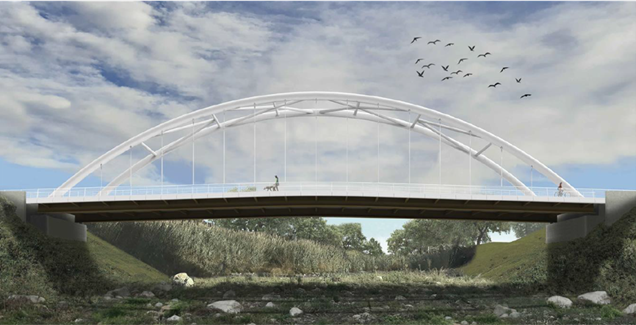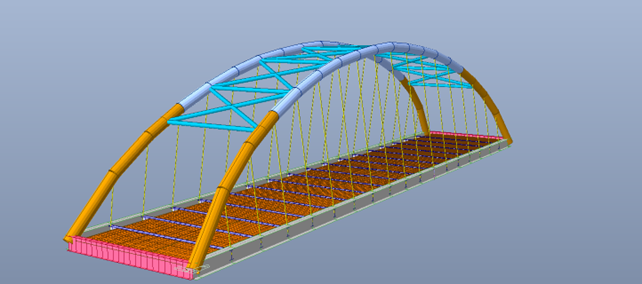Author: ing. Edoardo Runcio
Tutor: prof. ing. Marco Zucca
Master: Progettazione sismica delle strutture per costruzioni sostenibili
Il presente studio riguarda la progettazione dell’intervento di messa in sicurezza del ponte stradale sul torrente Leale nel comune di Trasaghis (UD), in quanto non garantisce un sufficiente franco idraulico rispetto al tirante di piena con tempo di ritorno di 200 anni. A seguito di una serie di indagini storiche si è evidenziato come né l’impalcato né le pile fossero di pregio artistico e pertanto ne è stata concessa la demolizione con ricostruzione. I due requisiti fondamentali per la progettazione sono stati la velocità di esecuzione dei lavori, che, in quanto finanziamento P.N.R.R., devono essere conclusi in un anno dalla consegna all’impresa, e l’ottimizzazione dell’altezza dell’impalcato. Quest’ultimo aspetto è particolarmente rilevante, poiché la quota delle spalle risulta inferiore a quella dell’acqua durante la piena e quindi necessitano di essere innalzate, generando un dislivello tra la quota del piano stradale attuale e quella finale sul ponte. Per limitare l’altezza delle rampe risulta fondamentale che l’impalcato sia il più snello possibile.
Di fronte a queste due problematiche si è ritenuta una scelta ottimale quella di ricorrere al ponte ad arco a spinta eliminata, che, su una luce come quella di progetto, pari a 55 m, garantisce il soddisfacimento di entrambi i requisiti. A partire da un dimensionamento di massima della struttura sulla base di formulazioni semplificate fornite dalla letteratura, si è proceduto alla sua modellazione ad elementi finiti, svolgendo un’analisi dinamica lineare. In un primo momento è stata svolta l’analisi con vincoli fissi alla base, per poi procedere con l’inserimento dei dispositivi di appoggio, appositamente progettati in maniera da rispettare i requisiti imposti dalla normativa vigente D.M.17/01/2018.
Si sono svolte le verifiche sugli elementi strutturali nelle tre condizioni: stati limite ultimi, stati limite di salvaguardia della vita (sismici) e per le fasi costruttive, durante le quali non è possibile considerare la presenza della soletta collaborante in c.a. Particolare attenzione è stata prestata al progetto delle connessioni tra elementi metallici, anche in nell’ottica di garantire la loro durabilità. Infine si è proceduto al dimensionamento delle fondazioni, caratterizzate da pali trivellati con lunghezza differente per le due spalle, considerando non solo il problema della portanza, ma anche quello dei massimi cedimenti verticali e laterali che la struttura può accettare. Per tutte le verifiche si sono svolte le necessarie validazioni rispetto a semplici calcoli manuali basati su formulazioni semplificate.
FOR INTERNATIONAL STUDENTS
The present work concerns the design of the intervention for the safety of the road bridge over the river Leale in the municipality of Trasaghis (UD), as it does not guarantee a sufficient height on the level of the water with return time of 200 years. Following a series of historical investigations, it was shown that neither the deck nor the piers were of artistic value and therefore it was allowed to be demolished with reconstruction. The two fundamental requirements for the planning have been the speed of execution of the structure, that, as financing by P.N.R.R., must be concluded in a year from the delivery to the construction company, and the optimization of the thickness of the deck. This last aspect is particularly relevant, since the height of the shoulders is lower than that of the water during the flood and therefore need to be raised, generating a difference in height between the current road level and the final one on the bridge. To limit the height of the ramps it is essential that the deck is as slender as possible.
Faced with these two problems, it was considered an optimal choice to adopt to the arched bridge “Langer”, which, on a span like that of the the design, equal to 55 m, ensures the fulfilment of both requirements. Starting from a rough dimensioning of the structure on the basis of simplified formulations provided by the literature, its finite element modeling was carried out with a linear dynamic analysis. At first the analysis was carried out with fixed constraints at the base, and then proceed with the insertion of support devices (considered as sprins), specially designed in order to comply with the requirements imposed by current legislation D.M.17/01/2018.
The checks on the structural elements were carried out in the three conditions: ultimate limit states, life-saving limit states (seismic) and for the construction phases, during which it is not possible to consider the presence of the collaborating slab in c.a. Particular attention has been paid to the design of the connections between steel elements, also in order to ensure their durability. Finally, we proceeded to the dimensioning of the foundations, characterized by drilled piles with different lengths for the two shoulders, considering not only the problem of bearing resistance, but also that of the maximum vertical and lateral movements that the structure can accept. For all the verifications the necessary validations were carried out compared to simple manual calculations based on simplified formulations.


